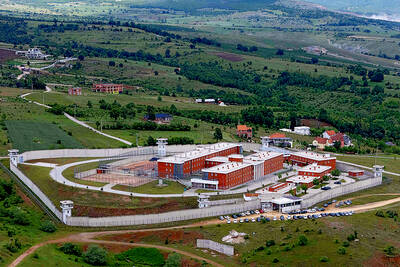South Africa's most prolific mass murderer takes another sip of coffee, eases back in his chair and pauses when asked if it is true he shot more than 100 black people.
"I can't argue with that," Louis van Schoor says. "I never kept count."
Seated at a restaurant terrace in East London, a seaside town in the Eastern Cape, the former security guard is a picture of relaxed confidence, soaking up sunshine while reminiscing about his days as an apartheid folk hero.
Hired to protect white-owned businesses in the 1980s, he is thought to have shot 101 people, killing 39, in a three-year spree.
Some were burglars; others were passers-by dragged in from the street. All of them were black or colored, the term for those of mixed race.
Convicted of murder but released from jail after 12 years, Van Schoor is unrepentant.
"I was doing my job -- I was paid to protect property. I never apologized for what I did," he says.
He is not the only one. The whites in East London who turned a blind eye to his killing spree have not apologized and whites in general, according to black clerics and politicians, have not owned up to apartheid-era atrocities.
That reluctance to atone has been laid bare in a book published last week, The Colour of Murder, by Heidi Holland, which investigates the bloodsoaked trail not only of Van Schoor but also his daughter, Sabrina, who hired a hitman to murder her mother.
The macabre tale is likely to reignite debate about those whites who shun the spirit of the Truth and Reconciliation Commission and mock rainbow nation rhetoric.
"The story is of a family but it is also the story of a divided country and of the people of that country trying to find new ways to live with each other," says Holland.
Since his release two years ago, after benefiting from a sentence reduction for all convicts issued by Nelson Mandela when he was president, Van Schoor, 55, has slimmed down, shaved off his beard and kept a low profile, working as a cattle farm foreman outside East London. During his 1992 trial white residents displayed "I Love Louis" stickers decorated with three bullet holes through a bleeding heart. Sympathy endures, says Van Schoor.
"The reaction is 90 percent positive. Strangers say, `Hey, it's good to see you,'" he says.
Magistrates and the police, grateful for the terror instilled in black people, covered his tracks until local journalists and human rights campaigners exposed the carnage as apartheid crumbled. Van Schoor was convicted of seven murders and two attempted murders.
Upon his release in 2004, Van Schoor said he had found God and, when prompted, expressed sorrow to his victims' relatives.
"I apologize if any of my actions caused them hurt," he says.
In an interview this week, he tried to clarify his position.
"I never apologized for what I did. I apologized for any hurt or pain that I caused through my actions during the course of my work," he explains.
Thanks to his changed appearance and low profile he has faced no backlash. Few black people recognize him, including the bookseller who took his order for The Colour of Murder. When Van Schoor gave his name, the penny dropped.
"She nearly fell off her chair," he says, smiling.
Married four times and now engaged to a local woman, Van Schoor, speaking softly and warily, says he is "happy and content". But he does not seem to approve of the new South Africa.
"Everything has changed -- people's attitudes, the service in shops, it's not the same," he says.
On the contrary, lament black leaders, one crucial thing has stayed the same: the refusal of many whites to admit past sins.
Archbishop Desmond Tutu, a Nobel peace laureate, recently said the privileged minority that once feared retribution had not shown enough gratitude for peaceful inclusion in a multi-racial democracy.
Bust East London does boast at least one white advocate of racial harmony: Van Schoor's daughter, Sabrina, 25. While her father was in jail she shocked the white community by dating black men and giving birth to a mixed-race child.
In 2002, in a grisly irony, she hired a black man to slit her mother's throat, claiming she was a racist bully.
Convicted of murder and sent to the same prison as her father, Sabrina van Schoor is seen as a martyr by some black people. She is popular among fellow inmates at Fort Glamorgan jail.
Speaking through iron bars, Sabrina says she is nervous about her family coming under public scrutiny again because of the book.
"I'm afraid it might open old wounds," she says.

Packed crowds in India celebrating their cricket team’s victory ended in a deadly stampede on Wednesday, with 11 mainly young fans crushed to death, the local state’s chief minister said. Joyous cricket fans had come out to celebrate and welcome home their heroes, Royal Challengers Bengaluru, after they beat Punjab Kings in a roller-coaster Indian Premier League (IPL) cricket final on Tuesday night. However, the euphoria of the vast crowds in the southern tech city of Bengaluru ended in disaster, with Indian Prime Minister Narendra calling it “absolutely heartrending.” Karnataka Chief Minister Siddaramaiah said most of the deceased are young, with 11 dead

By 2027, Denmark would relocate its foreign convicts to a prison in Kosovo under a 200-million-euro (US$228.6 million) agreement that has raised concerns among non-governmental organizations (NGOs) and residents, but which could serve as a model for the rest of the EU. The agreement, reached in 2022 and ratified by Kosovar lawmakers last year, provides for the reception of up to 300 foreign prisoners sentenced in Denmark. They must not have been convicted of terrorism or war crimes, or have a mental condition or terminal disease. Once their sentence is completed in Kosovan, they would be deported to their home country. In

Brazil, the world’s largest Roman Catholic country, saw its Catholic population decline further in 2022, while evangelical Christians and those with no religion continued to rise, census data released on Friday by the Brazilian Institute of Geography and Statistics (IBGE) showed. The census indicated that Brazil had 100.2 million Roman Catholics in 2022, accounting for 56.7 percent of the population, down from 65.1 percent or 105.4 million recorded in the 2010 census. Meanwhile, the share of evangelical Christians rose to 26.9 percent last year, up from 21.6 percent in 2010, adding 12 million followers to reach 47.4 million — the highest figure

LOST CONTACT: The mission carried payloads from Japan, the US and Taiwan’s National Central University, including a deep space radiation probe, ispace said Japanese company ispace said its uncrewed moon lander likely crashed onto the moon’s surface during its lunar touchdown attempt yesterday, marking another failure two years after its unsuccessful inaugural mission. Tokyo-based ispace had hoped to join US firms Intuitive Machines and Firefly Aerospace as companies that have accomplished commercial landings amid a global race for the moon, which includes state-run missions from China and India. A successful mission would have made ispace the first company outside the US to achieve a moon landing. Resilience, ispace’s second lunar lander, could not decelerate fast enough as it approached the moon, and the company has